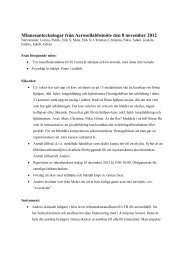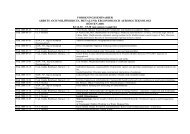ESTIMATING CLOUD DROPLET EFFECTIVE RADIUS ... - CAST
ESTIMATING CLOUD DROPLET EFFECTIVE RADIUS ... - CAST
ESTIMATING CLOUD DROPLET EFFECTIVE RADIUS ... - CAST
- No tags were found...
You also want an ePaper? Increase the reach of your titles
YUMPU automatically turns print PDFs into web optimized ePapers that Google loves.
<strong>ESTIMATING</strong> <strong>CLOUD</strong> <strong>DROPLET</strong> <strong>EFFECTIVE</strong> <strong>RADIUS</strong> FROM SATELLITE REFLECTANCE DATAModified Exponential Approximation___________________________________________________________________________________________________Dividing Eq. (2.12) by σ e,λ ⋅n⋅dz generates the general radiative transfer equation (Liou 2002,p. 28; Liou 1992, p. 109).dI= −Iλ + J λ(2.14)σ n ⋅ dze,λThis equation is the fundamental relationship in radiative transfer problems, where thesolution may give information on several radiative parameters such as optical thickness,single scattering albedo, effective radius etc.2.1.3 Asymptotic theory and Reflection functionThe discrete ordinate method, developed by Chandrasekhar in 1950, is an exact method forsolving radiative transfer problems numerically (Rybicki, 1996). The method is often used foraccurate calculations of radiative properties of cloudy atmospheres (Liou, 1992, p. 108). Oneof the main products from the discrete ordinate method is the reflectance function (in remotesensing often referred to as Bidirectional Reflection Distribution Function or simply BRDF)which gives the reflected intensity in relation to incident solar flux F 0 density. The reflectanceis defined as follows:R(τ;µ , µ0πIr( τ = 0; µ , φ), φ)= (2.15)µ F00Here I r denotes the intensity of the reflected light at top of the atmosphere (TOA), in thedirection (µ,φ), where µ = |cos(v)|, µ 0 = cos(v 0 ) and φ = |ϕ-ϕ 0 | (Kokhanovsky et al., 2003). Inremote sensing studies of clouds the reflectance I r , and hence R, is however measured in nonorweakly absorbing wavelengths, therefore the loss in intensity due to water vapourabsorption is often neglected and I r is approximated to the intensity at cloud top.Knowing parameters such as cloud optical depth τ, single scattering albedo ω 0 and effectiveradius r e one should be able to predict the reflection function from the viewing geometry.However, often the problem is the reverse. From satellite observations the reflectance of acertain viewing geometry is given, while information on optical depth and effective radius isdesired. The fact that reflectance in the visible (nonabsorbing) wavelengths is mainly afunction of optical thickness while reflectance in the NIR and MIR (absorbing) wavelengthsis governed by effective radius makes it possible to determine the optical thickness andeffective radius using reflectance data from two or more wavebands. For large opticalthickness (≥12) the sensitivity of the nonabsorbing and absorbing wavelengths to these twoparameters are almost orthogonal, so τ and r e can be determined nearly independently of eachother (Nakajima and King, 1990). Figure 4a and 4b illustrates how the reflection function inthe visible and NIR is governed mainly by optical thickness and effective radius, respectively.Running the numerical methods backwards is often not possible, so the approach is to makepre-calculated look-up tables of the reflection function at given viewing geometry and cloudparameters. This method is slow, and if conditions (ground surface albedo, phase functionrepresentation) are changed, new look-up tables must be created. Thus, when dealing withsatellite images, with thousands of pixels being analysed with varying conditions, a simpler,analytical method may be desirable. Therefore another approach called the asymptotic theoryis often used for optically thick clouds. The underlying principle is that when opticalthickness is large enough the numerical solution of radiative transfer is close to the known9




